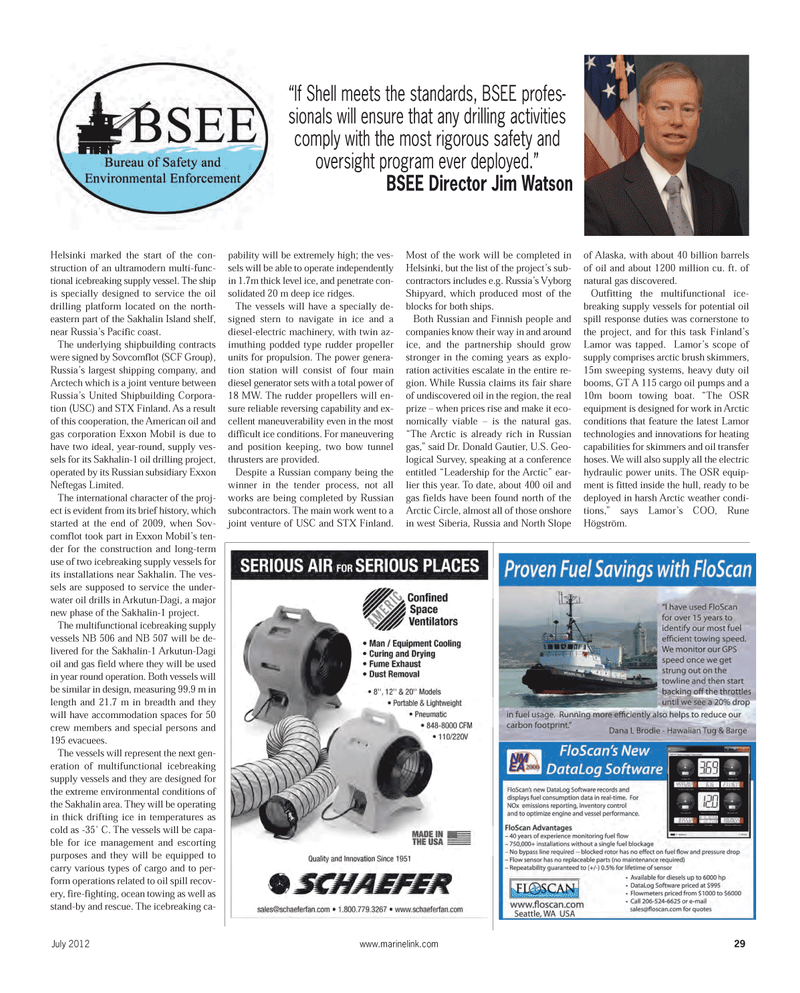
Page 29: of Maritime Reporter Magazine (July 2012)
Arctic Operations
Read this page in Pdf, Flash or Html5 edition of July 2012 Maritime Reporter Magazine
July 2012www.marinelink.com 29Helsinki marked the start of the con- struction of an ultramodern multi-func-tional icebreaking supply vessel. The ship is specially designed to service the oildrilling platform located on the north-eastern part of the Sakhalin Island shelf,near Russia?s Pacific coast. The underlying shipbuilding contracts were signed by Sovcomflot (SCF Group), Russia?s largest shipping company, and Arctech which is a joint venture between Russia?s United Shipbuilding Corpora- tion (USC) and STX Finland. As a result of this cooperation, the American oil and gas corporation Exxon Mobil is due to have two ideal, year-round, supply ves- sels for its Sakhalin-1 oil drilling project,operated by its Russian subsidiary ExxonNeftegas Limited. The international character of the proj-ect is evident from its brief history, which started at the end of 2009, when Sov- comflot took part in Exxon Mobil?s ten- der for the construction and long-termuse of two icebreaking supply vessels for its installations near Sakhalin. The ves- sels are supposed to service the under- water oil drills in Arkutun-Dagi, a major new phase of the Sakhalin-1 project. The multifunctional icebreaking supplyvessels NB 506 and NB 507 will be de- livered for the Sakhalin-1 Arkutun-Dagi oil and gas field where they will be used in year round operation. Both vessels will be similar in design, measuring 99.9 m inlength and 21.7 m in breadth and they will have accommodation spaces for 50 crew members and special persons and 195 evacuees. The vessels will represent the next gen- eration of multifunctional icebreakingsupply vessels and they are designed for the extreme environmental conditions of the Sakhalin area. They will be operating in thick drifting ice in temperatures ascold as -35 C. The vessels will be capa- ble for ice management and escortingpurposes and they will be equipped to carry various types of cargo and to per- form operations related to oil spill recov- ery, fire-fighting, ocean towing as well as stand-by and rescue. The icebreaking ca- pability will be extremely high; the ves- sels will be able to operate independentlyin 1.7m thick level ice, and penetrate con- solidated 20 m deep ice ridges.The vessels will have a specially de- signed stern to navigate in ice and a diesel-electric machinery, with twin az- imuthing podded type rudder propellerunits for propulsion. The power genera- tion station will consist of four maindiesel generator sets with a total power of 18 MW. The rudder propellers will en- sure reliable reversing capability and ex- cellent maneuverability even in the most difficult ice conditions. For maneuvering and position keeping, two bow tunnel thrusters are provided. Despite a Russian company being the winner in the tender process, not allworks are being completed by Russian subcontractors. The main work went to a joint venture of USC and STX Finland. Most of the work will be completed in Helsinki, but the list of the project?s sub- contractors includes e.g. Russia?s Vyborg Shipyard, which produced most of the blocks for both ships.Both Russian and Finnish people andcompanies know their way in and around ice, and the partnership should grow stronger in the coming years as explo- ration activities escalate in the entire re- gion. While Russia claims its fair share of undiscovered oil in the region, the real prize ? when prices rise and make it eco- nomically viable ? is the natural gas. ?The Arctic is already rich in Russian gas,? said Dr. Donald Gautier, U.S. Geo- logical Survey, speaking at a conference entitled ?Leadership for the Arctic? ear- lier this year. To date, about 400 oil and gas fields have been found north of the Arctic Circle, almost all of those onshorein west Siberia, Russia and North Slopeof Alaska, with about 40 billion barrels of oil and about 1200 million cu. ft. ofnatural gas discovered. Outfitting the multifunctional ice- breaking supply vessels for potential oil spill response duties was cornerstone to the project, and for this task Finland?s Lamor was tapped. Lamor?s scope of supply comprises arctic brush skimmers,15m sweeping systems, heavy duty oil booms, GT A 115 cargo oil pumps and a 10m boom towing boat. ?The OSR equipment is designed for work in Arctic conditions that feature the latest Lamortechnologies and innovations for heating capabilities for skimmers and oil transferhoses. We will also supply all the electric hydraulic power units. The OSR equip- ment is fitted inside the hull, ready to be deployed in harsh Arctic weather condi- tions,? says Lamor?s COO, Rune Högström.?If Shell meets the standards, BSEE profes- sionals will ensure that any drilling activities comply with the most rigorous safety and oversight program ever deployed.? BSEE Director Jim Watson MR#7 (26-33):MR Template 7/9/2012 9:41 AM Page 29

 28
28

 30
30
